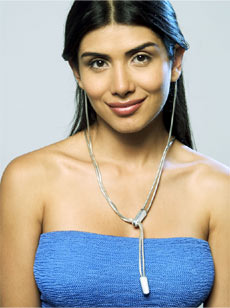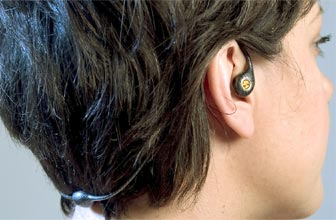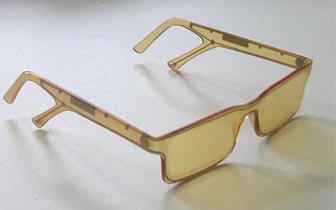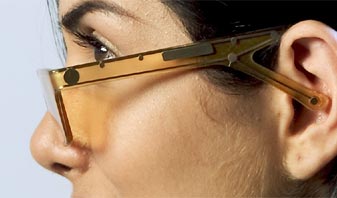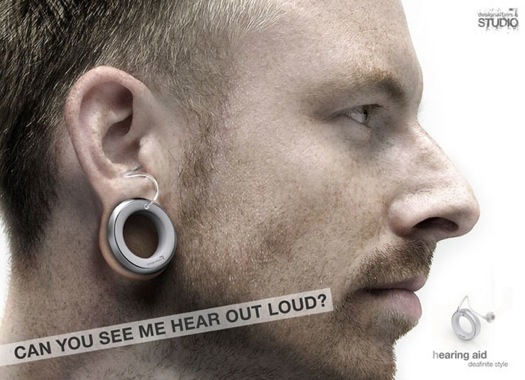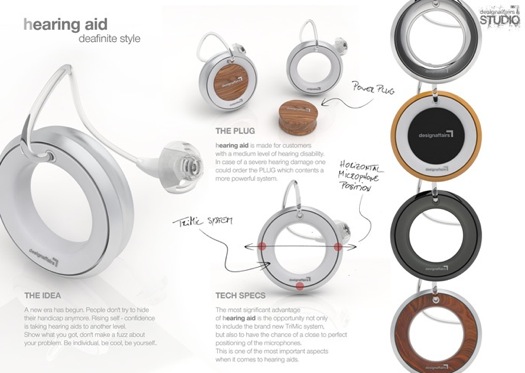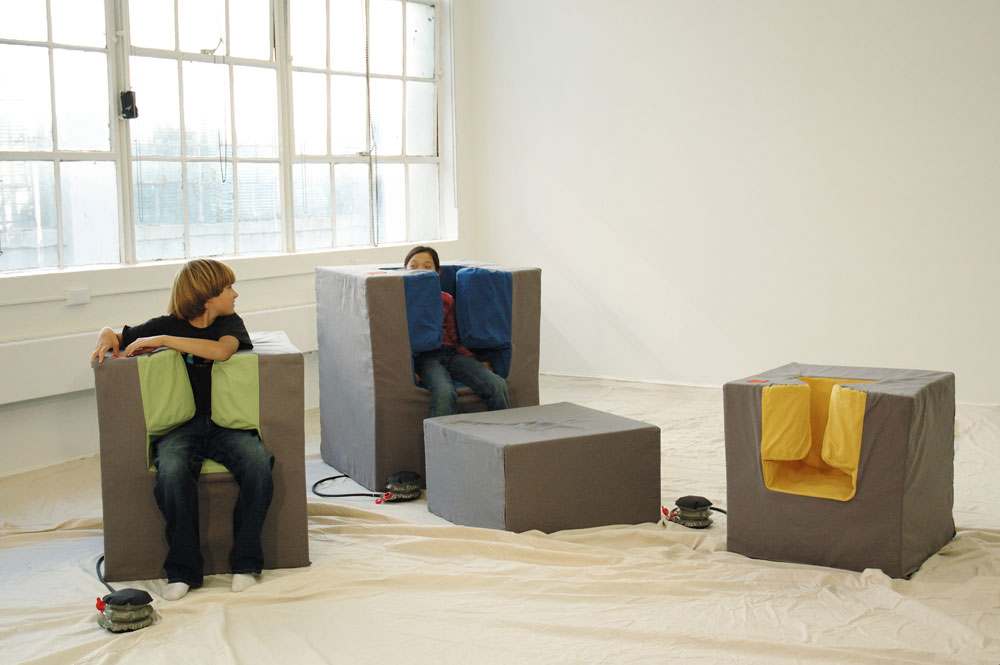year
post
May 1, 2010
2010 05 01 Adaptation Part Ii Hearing Aid Jewelry Chairs That Give Hugs And The Art Of Changing The Question
In Part I of this series, I wrote about the still-new territory that is true adaptive design. As shown in the case of the Eames chairs, we've only begun to explore the aesthetic-and-engineering innovations that may shift our cultural ideas about ability and disability, independence and dependence, normalcy and variation.
Let me point to some exciting design frontiers in our own day, and then I'll try to suggest what the value of artists is in these collaborations, in the hopes of keeping the cultural questions wide-ranging and ambitious.
Graham Pullin points out that eyeglasses are perhaps the most commonplace adaptive aid around today. They're now so familiar that we think of glasses more as fashion accessories than anything else: visual statements about who we are, our professions or preferences.
"Eyewear is one market in which fashion and disability overlap. On the rare occasions that the words design and disability are mentioned in the same breath, glasses are often referred to as the exemplar of a product that addresses a disability, yet with little or no social stigma attached. This positive image for disability has been achieved without invisibility." (from Design Meets Disability)
If a technology like eyeglasses can evolve so far beyond pure function, into a desirable aesthetic realm (and, presumably, to ever-more-refined functionality), why can't other technologies do the same? These innovations have the potential to de-stigmatize, even naturalize, the normal human variation that we know as disabilities of various kinds. And they may lead to innovations outside the realm of accessibility concerns.
Hearing aids, for example, have until recently been neglected in the design field, but the potential exists for them not only to improve hearing for those who need it, but provide an augmented hearing experience—perhaps even a more desirable and customized hearing experience.
In 2005-06, the Victoria & Albert Museum held an exhibit called "Hearwear," showcasing 15 designers who've tackled the design challenge of the hearing aid. A few examples:
The Svara hearing aid "necklace" by The Brewery in London. DesignBoom's coverage of this show says that the amplification for this device is controlled by subtle, naturalistic movements—tucking hair behind one's ears, moving the pendant up or down.
"The Beauty of Inner Space," Ross Lovegrove's carbon composite, gold, and silicone "earrings"—intended, according to the designer, for canceling out noise pollution and amplifying the sounds we want to hear.
"Surround Sound" by Industrial Facility—a play on eyeglasses that function as hearwear. Here the wearer has a heightened level of control over his/her hearing—sounds are directed to the device by which direction the wearer is looking.
And, for the die-hard hipster set, there's this model:
This proposal by Design Affairs, via PSFK. (Thanks to Kevin Hamilton for sending along!)
There are more examples at the V&A exhibition site.
I quote Nicolas Bourriaud on my site mission page, and I'll cite his words here again that
art only realizes its critical duty with regard to technology from the moment when it shifts its challenges. (from Relational Aesthetics)
Artists should be about the business of shifting challenges, or shifting the "acceptable questions" at hand.* In other words, there's presuming that a hearing impairment is an inherent lack, and therefore asking: "How well can we 'hide' a functional hearing aid, to blend in with the flesh surrounding it?" And then, instead, there's asking: "What would a visually striking hearing aid look like? What would make you want to wear it? If we grant visibility to this kind of aid, how does it alter our view of its user?" And, most provocatively: "What else might a hearing device do, that's so far not been imagined?"
I'm a little haunted by the casual claim I came across in an interview with artist-and-engineer Natalie Jeremijenko that "the art world is a prissy little thing over in the corner, while the major cultural forces are being determined by technoscience."
My sense is that, despite lip service to the contrary, artists have contented themselves too often with work that reacts to, comments upon, or critiques (by illustration, or playful mimicry, or one-note criticism) a received set of dominant cultural values—values that are now often driven by classic-model scientific experimentation and possibility. Even though there's plenty of complaints among artists about their relative marginality in cultural conversations, the sub-specialization and self-consciousness of art-speak generally only reinforces that marginality. I think some of the work above, and work that I'll show in future series installments, attempts to shape values from their first principles, and therefore from their origins as embodied material or media. And neither the scientific inquiry nor the artistic concerns can be omitted.
Let me add here an artist's collaborative project around a less visible example of disability (or "neurodiversity," depending on your point of view).
Temple Grandin is a research scientist in animal husbandry, and now a well-known self-advocate for people with autism spectrum conditions. (Here's her recent TED talk on autism and education; she is also the subject of a recent HBO bio-pic.) Grandin has revolutionized the cattle slaughter process, creating far more humane tools and practices for a huge percentage of slaughterhouses all across the U.S.
Along the way, one of the technologies she developed is a "hugging machine" that provides a deep, calming pressure to cows as they enter the conveyor belt toward their deaths. The pressure creates stillness, reduces panic, and makes for a cleaner, less violent death for the animal.
As she developed this machine for cattle, Grandin intuited her own need for an adaptive "hugging machine" that would provide her with a proxy for human touch—for someone whose interpersonal interactions were often confusing, she found that this machine delivered a kind of affection and calming influence that she needed but wouldn't get from a typical kind of human relationship.
Artist and MIT professor Wendy Jacob proposed a collaboration with Grandin to modify and replicate the hugging machine—in the form of these "squeeze chairs"—furniture that gives you a hug.
These chairs have been used in classrooms, adapted for students with autism spectrum conditions, but they reveal something far beyond their origins as well.
Questions of utility matter: Does it work efficiently? Is its power maximized? Is it user-friendly? Can it be mass produced, affordably? But questions outside utilitarian concerns also matter: when we alter, invert, hack, and otherwise playfully interrupt the intentions around a possible technology, what more might we know about being human?
In Part III of this series, I'll explore what theorist Mitchell Whitelaw has particularly praised in new media (and, I would add, new genre) art: the "nonindustrial latitude" that artists are afforded when tackling big questions alongside the tools and techniques within science-and-technology environments. The capacity to change the questions assumed by technological and scientific advances, and the suggestion of unnamed possibilities.
That latitude is what's interesting to me—it's what may come most readily to the habits of mind in artistic practice, and it's perhaps one of the most valuable contributions toward un-doing a pure literalism in solving issues of disabled access—and by extension, defining community.
I'd love your feedback along the way!
*note: Here, yes, I am loosely arguing with Thomas Kuhn's definition of an established (small-p) paradigm in mind, and the ways that an entrenched paradigm may be changed.

